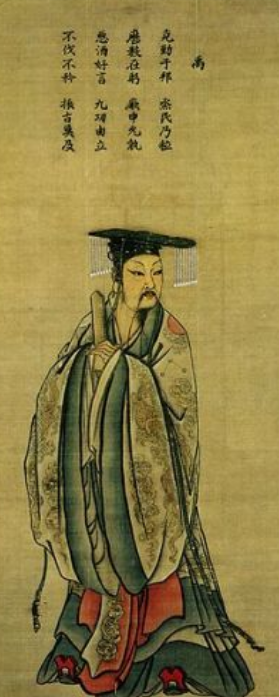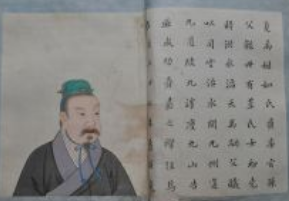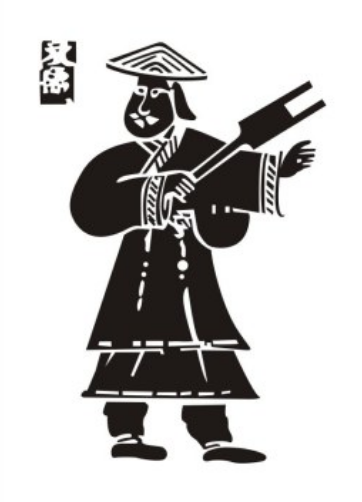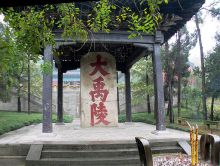From the Yellow Emperor Xuanyuan to Yu, there are eight generations: Father of Yu, Father Jiu, Father Jiu’s fifth ancestor is Zhuan Xu, Father of Zhuan Xu is Chang Yi, the second son of the Yellow Emperor born to Rayu. His father, Jiu Jiu, was sealed in the Wenshan Shiniu area (today’s Beichuan County, Sichuan Province), and his mother was a daughter of the Youxin clan named Nuzhi, also known as Niu Hi. When Yu was young, he moved east with his father, Father Jiu, to the Central Plains. His father, Jiu Jiu, was sealed by Emperor Yao in Chong (Mt. Zhongyue). At the time of Emperor Yao, the Central Plains was flooded with water and the people were in great distress. Father Father Father ordered Father Father to control the floods. Father Father Father used the water barrier method, that is to say, set up a river bank on the shore, but the water flooded higher and higher, and it took nine years to quell the floods. Then Father Jiu’s son Yu was appointed to succeed him in the post of water control. Holding a s Lei 耜 in his hand, Yu immediately joined Yi and Hou Ji to gather the people to come and assist him as he inspected the river and reviewed the reasons for the failure of Father Ji’s water control. Yu summed up the lessons of his father’s failure and reformed his water management methods to channel the river
About 9 minutes to read
Introduction
Da Yu (大禹), surnamed Si (姒), was the grandson of Zhuan Xu (颛顼), the grandson of the Yellow Emperor (黃帝), and the sixth grandson of Zhuan Xu (颛顼).
Biography
Early Years

Da Yu
Yu was the grandson of the Yellow Emperor, grandson of Zhuan Xu, and son of Father Father Father (but some say that Yu should be the sixth grandson of Zhuan Xu). The place of birth is controversial (one says it was in the Shiniu area of Wenshan; another says it was in Shi O). His mother was a daughter of the Youxin clan (today’s Cao County, Shandong Province), named Nuzhi, also known as Shuji. When Yu was young, he moved east with his father, Father Jiu, to the Central Plains. His father, Father Father Jiu, was sealed in Chong by Emperor Yao. At the time of Emperor Yao, the Central Plains was flooded with water and the people were in great distress. Jiu Jiu was ordered to control the floods. Jiu Jiu used the water barrier method, i.e., he set up river dikes on the banks, but the water flooded higher and higher, and it took nine years to quell the floods. Then Yu was appointed as the Secretary of State to take over the task of water control. This is the best proof that Yu worked so hard to control the water that he did not enter the house three times.
Immediately, Yu, together with Yi and Houji, gathered the people to assist him. He inspected the river and reviewed the reasons for Father Ji’s failure. Summing up the lessons of his father’s failure, Yu reformed his water management methods to take advantage of the natural tendency of water to flow lower and dredged the nine rivers. During the water control period, Yu crossed mountains, rivers and streams, taking measuring instruments and tools, measuring the height of the terrain from west to east, setting up benchmarks and planning waterways. He led the water treatment workers to travel all over the region and, according to the benchmarks, he opened up mountains and built dikes in every depression in order to dredge the waterways and divert the flood waters into the sea. Yu personally led the common people to sleep and sleep in the open, and spent all day in the mud and water to dredge the rivers and channel the water from the flat land into the rivers and then into the ocean. After 13 years of treatment, he finally succeeded in eliminating the scourge of flooding in the Central Plains. As a token of their gratitude for his success, people called him “Dayu”, or “Great Yu”.
In the process of healing the floods, Yu traveled all over the world and knew all the topography, customs, and products. Yu re-defined the world into nine states and set the tribute for each state. Emperor Yu also stipulated that the area 500 miles beyond the empire of the Son of Heaven was called the Dien service, another 500 miles beyond that was called the Hou service, another 500 miles beyond that was called the Sui service, another 500 miles beyond that was called the Want service, and the outermost 500 miles was called the Desolate service. The three services, i.e. Dian, Hou, and Sui, were for different goods or different services. In the case of the “important service”, there was no service, but only the requirement to accept discipline and obey the laws and regulations. In the case of the wild service, it was administered according to their customs, without enforcing the central imperial government.
To take the throne

Xia Yu
Mengzi – Wanzhang Shang (Mencius – Wanzhang Shang) states that “Yu took refuge from the sons of Shun in Yangcheng”, the Ancient Book of Bamboo Chronicles states that “Yu lived in Yangcheng”, and the Shi Ben – Jue Chapter states that “Xia Yu’s capital was Yangcheng, which also took refuge from Shang Jun, and was also in Pingyang, or in Anyi, or in Jingyang “, and “Shiji – Xia Benji” says “Yu resigned to avoid Shang Jun, son of Shun, in Yangcheng”. From the relevant documents, it can be seen that the relationship between Xia Yu and Yangcheng and Pingyang was very close.
When Emperor Shun reigned for thirty-three years, he formally ceded the throne of heaven to Yu. Seventeen years later, Shun died during his southern tour. At the end of three years of mourning, Yu took refuge in Yangcheng, a small euphemism in the Xia region, and ceded the throne to Shun’s son, Shang Jun. But all the lords of the world left Shang Jun to make a pilgrimage to King Yu. With the support of the lords, Yu formally assumed the throne and lived in Yangcheng with the name Xia. He was assigned Dan Zhu in Tang and Shang Jun in Yu. The calendar was changed to the Xia calendar, with the month of Jian Yin as the first month. It is written in the Sermon that Yu “had a small palace, a thin diet, a third class of earth, and fine clothes.”
Death
The tenth year of Yu’s reign eastward travel, to the Huiji died after (Bamboo Book Chronicle of 45 years), Huang Fu Qu believes that Yu was about 100 years old. After Yu’s death, his son Qi succeeded him as the son of Heaven of the Xia Dynasty.
Anecdotal Allusions
Three times through the door of a house but not entering

The Great Yu
Legend has it that soon after his new marriage to Jiao, a woman from the Tushan clan, Yu left his wife and set out on the road to heal the waters. Later, when he passed by his home, he heard the sound of his wife giving birth and his son crying, but once he thought of the urgent need to open the mountain and divert the flow, he could not think of going home and went back to the water treatment line. The third time he passed by his hometown, his son Kai was being held in his mother’s arms, and he already knew how to call his father and wave his little hand to greet Yu, who just waved to his wife and son to show that he saw them, and still did not stop.
Excavating the Dragon Gate
More than 4,000 years ago, the first emperor of the Xia Dynasty, Dayu, led the people to “dredge the rivers and guide the stagnant waters”, “combine the four seas” and “do their best to ditch the ditches”, so it is said that the Luo River and the Yi River were also dredged by Dayu.
It is said that at that time, there was an endless ocean south of Longmen Mountain, and people were in great distress and drowned. Dayu was well aware of the suffering of the floods. The Great Yu was aware of the suffering of the flood and led the people to dredge the nine rivers and guide the hundred rivers, finally forcing the flood to flow back to the sea.
The Book of Yue Jue Shu, Volume 1, says: “When Yu was in the cave, he used copper as a soldier to cut the Ique and pass through the Dragon Gate.”
The Water Classic Note says: “In the past, when Dayu was spreading the water, the two mountains were opposite to each other, looking at them as if they were queues, and the water of Yi was in between, so it was called Yi Que.”
The book of Han Dynasty – Ditch and Ditch Zhi” Jia jan zuo said, “In the past, Dayu ruled the water, the mountain tomb when the road was destroyed, so chiseled the dragon gate, open I Que.”
The meeting of Mount Tu
After the establishment of Xia, Dayu held a meeting of the lords at Mount Tushan as early as possible to review his faults. This meeting at Mount Tushan is generally considered a landmark event in the establishment of the Xia Dynasty in China. On the day of the official assembly, Dayu stood on the stage in his Dharma clothes, holding the Xuan Gui in his hand, while the four vassals were divided on both sides in the direction of his kingdom and bowed to Dayu, who also bowed in reply on the stage.
After the salute, Xia Yu said loudly to the lords, “I am not good enough to convince the people because of my weak virtue and little ability, so I have called this assembly in the hope that you will understand and earnestly rebuke, admonish, and exhort me so that I will know my faults and change them. Although I have worked hard to rule the land and the water, I am most cautious of the word pride in my life. The late emperor often admonished me by saying, ‘If you are not proud, the world will not compete with you; if you are not aggressive, the world will not compete with you for merit’. I will listen to your teachings with all ears.” Everyone understood that Yu was commanded by heaven, and when the lords who had originally had problems with him saw this attitude, they all expressed their respect and admiration and removed their original doubts. History records that “Yu met with the lords at Mount Tushan and held jade and silk for all the nations.
Casting of the Nine Cauldrons
After the meeting at Mount Tushan, the lords often came to Yangcheng to offer gold (i.e. bronze) as a token of respect. Later, as the copper tribute from the nine states increased year after year, Yu remembered that the Yellow Emperor Xuan Yuan had accomplished the casting of the tripods. The nine tripods (i.e., the Tripod of Jizhou, the Tripod of Yanzhou, the Tripod of Qingzhou, the Tripod of Xuzhou, the Tripod of Yangzhou, the Tripod of Jingzhou, the Tripod of Yuzhou, the Tripod of Liangzhou, and the Tripod of Yongzhou) were cast, and the tripods were decorated with the famous mountains, rivers, and exotic animals of each state. The nine tripods symbolize the nine states, of which the Yuzhou tripod is the central tripod, and Yuzhou is the central hub. The nine tripods were concentrated in Yangcheng, the capital of the Xia Dynasty, to show that Dayu, the king of Xia, had become the lord of all the states and the world had been unified since then. The Nine Cauldrons then became a symbol of the supremacy of kingship and the unity and prosperity of the country.
Character Evaluation
Xia Yu is a great historical figure who made great contributions to the development of the Chinese nation. His major achievement was not only to control floods, develop national production, and make people happy, but more importantly, to end the social organization of tribal alliances in primitive Chinese society and create a new social and political form called the “state. Xia Yu completed the establishment of the state, replacing primitive society with classes and barbaric society with civilized society, and promoting the historical development of the Chinese emperors.
Confucius: Yu, I have no interruptions. He ate and dined with filial piety to the ghosts and gods, wore evil clothes to the beauty of the embroidery, and did his best to ditch the palace. Yu, I have no interruptions.
Ji Zha: “Beautiful! Diligence but not virtue, not Yu who can repair it?”
Sima Qian: When Yao was hit by the flood, the people were starving. Yu diligent ditch, hands and feet calloused. The words of the man are four years old, and he moves in four times. He married his wife for a day, and did not go through the door privately. The nine lands were rationalized, and the Xuan Gui was made available.
In the Preface to the Book of Tai Shi Gong: “Yu’s work is shared by all the nine states, and his virtue flows to the Miao people.”
The codex records
The Records of the Grand Historian – Xia Benji
The Chronicles of the Bamboo Book – The Empress of Xia
The Century of Emperors – The Third (Xia)
Literary Image
The Long Novel Yao Shun Yu (by Xing Xing Yu)
Posthumous Tributes
Mausoleum
Located in Yuling Village, Yuling Township, Yuecheng District, Shaoxing City, Zhejiang Province, Yu’s tomb was built by later generations to celebrate and commemorate Dayu, the first ancient Chinese hero of water control and the founder of the Xia Dynasty. It consists of three main parts: the Yuling Mausoleum, the Yuling Shrine and the Yuling Temple. The buildings of Yuling are mainly reconstructed from the Ming, Qing and Republican Dynasties.
In the village of Yuling in Shaoxing, the descendants of Xia Yu surnamed Si have been guarding the tomb of Yu for generations, but Cang Xiu Liang pointed out that this claim is never credible.

Shaoxing Dayu Mausoleum
Rituals
After the destruction of the Xia Jie, the king of Shang Tang Feng Xia royal family surnamed Si a noble family in the country of Qi, in order to worship the ancestors of the temple. “Qǐ in the Shang, or sealed or extinct”. King Wu of the week after the destruction of the Shang for the king, sealed the descendants of King Yu in the Qiyi land, the continuation of the Qiyi state, in charge of the sacrifice of Yu. The sacrifice of King Yu was a national sacrifice.
In 210 B.C., Qin Shi Huang “went to Huiji and sacrificed to the Great Yu”. In 960 A.D., the Song Emperor issued an edict to protect Yu’s tomb, making the sacrifice to Yu a national norm. The Ming and Qing dynasties had the most complete rituals and systems and the grandest ceremonies, with the Ming and Qing dynasties each having more than 20 major sacrifices to Yu’s tomb. In 1933, the temple was restored again and a grand ceremony was held.
In Taoism, Yu is the Great Emperor of Water, and his birth date is October 15, the Day of the Lower Yuan.
Yu Wang Pond
Yu Wang Pond is located on the west hill of Longmen Grotto in Luoyang City, Henan Province, and is 8.80 meters long and 6 meters wide. Spring water from the stone cave, warm in winter and cool in summer, in the birth of algae. Pool in a boulder, called stone acupuncture, or stalagmite, sword stone, for the Taihu Lake stone, according to legend, the tool used by the Great Yu to excavate the Dragon Gate. Xia Yu water had “chisel I Que, through the Dragon Gate” move. According to the legend, the area south of Longmen Mountain was a vast ocean, and the people were poor and drowned. In order to solve the disaster brought by the flood, Dayu led people to control the flood and dredge the river, so that people could live and work in peace and happiness.
Yuwang Pond
King Yu Monument
The King Yü Monument is located on the pale purple stone wall at the top of Mount Yuelu, south of the Python Cave. It stands facing east. The inscription recounts and praises the great achievements of Dayu in healing water. The story of Dayu, who succeeded his father in healing the water, “did not listen to the music for seven years and did not enter the house for three times” has been passed down to this day.
The monument is 1.7 meters high and 1.4 meters wide, and the inscription is divided into nine lines of nine characters each, totaling 77 characters, with four blank characters at the end of the line. The text is shaped like a tadpole, different from both the oracle bones and the tadpoles of the pre-Han script, so it is difficult to identify, and is probably a Taoist talismanic record, or a forgery by Taoist priests. However, more than 1,200 years ago, Han Yu heard about it and climbed up the hill peak of Nangyue Mountain to visit the monument, and left a poem about it. Even if it is a forgery from the Tang and Song dynasties, it is still very precious as a monument commemorating the water treatment of the Great Yu. There are ten windy places in the country where the monument was engraved, and it is said that they were all copied from the Yuelu monument model.
Related Controversies
Controversy over the hometown
There are three theories about the hometown of Dayu, namely, that Dayu came from the Central Plains, from the Eastern Yei, and from the Western Rong.
Controversy over origin
No records of King Yu have been found in the excavated artifacts of his contemporaries or in the Shang oracle bones. The earliest artifact that can be found that mentions Yu is the Sui Gong Xue (遂公) from the Western Zhou Dynasty, about a thousand years later, as well as the Qi Hou Zhong (齊侯钟) and Qin Gong Gui (秦公簋).
According to Gu Jie Gang, the etymology of the character “Yu” is related to dragons, but was exaggerated to mean “Yu is a dragon”. This view was misinterpreted by historians such as Liu Yimou at the time.
Controversy over the opening of the Dragon Gate
Was it really Yu who excavated the Dragon Gate in Ique? This was already questioned in the Song Dynasty. For example, Sima Guang said in his “Chiseling the Dragon Gate” in Wenguo Wenzheng Gong Wenji: “Some people asked Yu to chisel the Dragon Gate to open up the Ique, and there were all sorts of questions. The day of the pedant Wen: ‘Dragon Gate I Que heaven is also made, Yu ruled the ear. Non mountain across its front, the north of the Yong not flow, Yu began to chisel and open it, and then pass.”
This means that the Dragon Gate and Iquan were formed naturally, not because the mountain crossed in front of it and blocked the flood water flowing north, but because the water did not flow smoothly, the Great Yu began to cut and open it, and then the river flowed smoothly. This statement seems to have some truth. Imagine that about 4,000 years ago, people mainly used stone tools, a large hard stone mountain how to open? Even the use of modern equipment to chisel, and how easy.
Modern geology tells us that Longmen Mountain was formed about 200,000 years ago in the late Pleistocene to early Holocene, and its body is composed of dolomite and limestone from the Middle and Late Cambrian, with many karst caves. These caves have long been washed by water and undergone drastic changes, thus forming a canyon and cutting the mountain apart. Although the water of Yihe River was blocked, it could still pass through, and was excavated by Yu at the rate of the people. The situation of the Dragon Gate in Iqiu is now. This explanation does not deny the merits of Yu, but is also in line with the logic and laws of natural development, and is therefore accepted by the world.